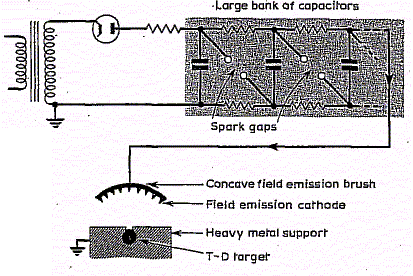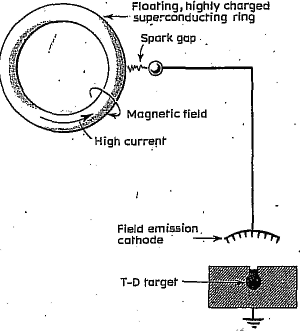
New Scientist
21 November-1968
How to light a mini-H-bomb
An American physicist, working in Trieste, has advanced a revolutionary, but convincing, proposal for a nuclear fusion trigger. Employing magnetically levitated, superconducting doughnuts, and intense field-ion emission, it would, hopefully, be too cumbersome for military application: its significance lies in unlimited power production.
Dr Peter Stubbs
is science editor of New Scientist
Man does not seem to be very good at directing the forces over which he has control; but whether the possession of an unlimited source of energy would create the Nirvana most of us believe, or simply a Hell-on-Earth, is an academic question. That is the direction in which we are headed and our arrival at such a destination is just a matter of time and the means we use to travel there. Perhaps we are still driven on by the inherited hatred begotten of sweated labor and the horrors manifested by industrial revolutions. Whatever the cause, one day we shall certainly be able to control thermonuclear fusion to creates vast quantities of cheap power.
The advent of this strange event and of the unimaginable world that would follow, may be much nearer than we think Basically the attainment of thermonuclear conditions in a suitable mixture of the heavy isotopes of hydrogen, deuterium and tritium, depends upon cramming enough energy, fast enough, into a small enough, volume of sufficiently dense material to heat it up to the nuclear ignition point. In the hydrogen bomb this trigger is a fission-bomb at its center stars are ignited by the conversion of huge amounts of gravitational energy into heat within their dense cores. But non-military Man, so far, has largely concentrated his efforts to house-train the unruly monster on the heating of dense gas plasmas held together in ever, more bizarre magnetic bottles. Although, as we reported a few weeks ago (see "Another rung on the fusion ladder, by Larry Miller, New Scientist, vol. 40, p. 186), researchers., continue to make some progress along these lines, it is slow work. There is a perverse tendency for; each advance to be accompanied by a fresh set of problems.
It is unlikely that we shall find the right route by anything so enchantingly uncluttered as Faraday's compass needle, and. wire coil but many physicists must, be wondering if there isn't some-neater short, cut to the goal which would circumvent the present tedious experiments and involved theoretical computations. In fact, one or two alternative suggestions have been voiced but they have carried too many conditional, clauses to sound convincing In a recent issue of Physical Review (vol. 174, no.1 p. 212), however, Professor F. Winterberg who works at the International Center for Theoretical Physics in Trieste puts forward a highly novel proposal for achieving controlled unclear fusion. His arguments are detailed arid the technique on paper entirely feasible.
The only bar to making very small hydrogen bombs is the critical mass of the fission bomb trigger. To induce two chunks of fissile uranium-235 to explode when they are rammed together, the total mass must be bigger than a certain amount. The explosion is thus always top big to control. The alternative, on which Winterberg's thesis is based, is to invent a smaller trigger, still capable of injecting energy into the mixture of light elements at a high enough rate. In the most suitable target, liquid or solid tritium-deuterium, this trigger must be able to force, more than 1014 ergs into a volume no bigger, than, a few cubic millimeters, hi a time no longer than a few thousand-millionths of a second.
These conditions for setting fire to a thermonuclear bonfire are pretty exacting. For comparison, one kilogram of TNT-produces an explosion of around 1014 erg. For power production or rocketry, Winterberg reckons you could handle, in a controlled manner, microsized hydrogen bombs delivering as much as one or perhaps ten kilotons of energy.
The idea of devising a smaller trigger for fusion devices is plainly not new. Apart from the attractions of an easy way to make fusion weapons, it has received attention from laser experts anxious to find new uses for their increasingly, powerful beams of light. Alas even the most promising of giant pulsed lasers falls a long way short of the energy concentration required.
Others, including Winterberg himself have pondered the possibility of accelerating dust particles to such high velocities — about 1000 km/s — that the conversion of the kinetic energy into heat on impacting with a tritium-deuterium target would ignite it Soviet physicists yet tried shining a laser beam at dust particles in the hope that the evaporation produced would send them whizzing away like minute jet-propelled projectiles. They can, in fact, reach sufficient velocities to simulate the conditions of meteoric dust.
Until another version of its concept is to accelerate superconducting dust fragments on a travelling magnetic wave. A suitable machine, however would gain, at the Italian National Nuclear Laboratory at Frascati experiments are in progress to try to ignite small fusion devices by compression with extremely, intense magnetic fields, these in turn being produced by .the energy release of a ton or so of conventional explosive Winterberg's new idea which I repeat, the has analyzed misconsiderable detail, is to light a small quantity of tritium-deuterium with an intensified-emission discharge essentially a damned great spark.
The technique seems feasible as a result of a laboratory development, described last year, by which the field-emission process is employed to produce highly intense electron beams with-a power as great as a million megawatts, and a duration of one to ten nanoseconds; Electrons with energies of several MeVs result for mine total electric currents in excess of 100000 amperes for their brief spate of glory. Here, surely, is the kind of punch we must use to knock light nuclei together into heavier ones? Given a big enough blob of target material, the fusion energy released will be fed back into the mixture and make it detonate.
The field-emission process is produced by discharging, in .a special way, a large bank of capacitors through a brush of cathodes bristling round a concave cavity, which focuses the streams of emitted electrons on to a small target area. The capacitor bank is connected together by a so-called Marx circuit which enables capacitors charged up at one voltage while they are connected in parallel to be switched suddenly through spark gaps so that they are then connected in series, multiplying the discharge voltage by the number of separate capacitors (see Figure 1). To date, such discharges have reached energies of about 1011 erg expended in some 10 nanoseconds — about a thousand times too of electrons Ions being much bigger would pull up more sharply in the target.
The existing techniques, Winterberg believes, if their dimensions were increased, would do the trick. Nevertheless, his obviously fertile imagination has come up with a radically new way to produce even more dramatic sparks. Ordinary capacitors are limited because of electrical breakdown initiated by electrons emitted at surface irregularities. In a suitably shaped device, a strong magnetic field plight loop these erring electrons back into their proper place and thus retain the charge at higher voltages.
A conceivable way to apply this principle, he argues, might be to take a thin superconducting doughnut, set up a permanent ring current in it, and levitate it magnetically so that it is isolated electrically within a high vacuum. You could then charge the ring to very much higher voltages than an ordinary capacitor. The ring current would produce low for Winterberg's fusion requirements, but with a fast time of about the right order of magnitude. The resulting beam could also be focused on a target area no more than a few millimeters across as would be needed.

Figure 1. In the Marx circuit capacitors connected in parallel are -suddenly switched by spark gaps so that they are in series. This multiplies the initial voltage by the number of capacitors, enabling the production of intense, fast streams of field-emission electrons.

Figure 2 A magnetically-levitated, superconducting ring, isolated in a high vacuum and carrying a strong electric current, might be charged up to gigavolt potentials before breakdown
In order to gain more energy from, the mini-bomb than you put in, the blob of tritium-deuterium would have to have a diameter of at least half a cm; it would probably have to be held in a block of heavy material to prevent it losing energy too rapidly by expansion, the chief source of energy loss. Rather more than five megajoules of energy would be required to ignite a half-cm sphere of liquid tritium-deuterium. Fast capacitor banks of one Ml have been built already; a 10-MJ one is currently on the stocks in the USA. In order to discharge energies of this magnitude in 10 nanoseconds without impossible high current densities; the electron emission brush would need some 300 cathodes. Whether or not. the focused current' would be stable can only be decided by experiment.
A more serious objection is that electrons with energies of several MeV would tend to overshoot a small target by several cm without delivering up their energy to it. They could, however, be made to curl up in the target by a strong magnetic field applied at the moment of discharge.
Alternatively — and this seems to be what Winterberg has in mind as the most promising line of attack you could use field-emitted ions instead its own magnetic field, winding around the dough-hut, which ought to stop delinquent electrons from sabotaging its charged state.
If the ring were coated with a normal conductor the supercurrent could be established within it by magnetic induction simultaneously, the magnetic flux lines could carry electrons from a glow discharge to the ring to charge, it up. It could otherwise be charged with an electron gun. Winterberg calculates that a length of 10-cm-diameter superconducting bar bent round into a ring three meters in diameter could be charged up to nearly one gigavolt, giving it a store of electrostatic energy equal to nearly 1015 ergs — substantially more than his fusion trigger demands, though it would have a longer discharge time. Even higher voltages might be reached, and-corresponding energies of the order, perhaps, of 1017 ergs. This energy would be extracted via a spark gap and used in a cathode brush as before (Figure 2). A final twist would be to substitute a hollow anode for each cathode element and blow gas through it to produce an intense field ion emission. The electric fields involved should be big enough to ionize the gas atoms. Only ten of these emitters might be necessary. Under these conditions the anodes might even disintegrate to create a stream of fast microparticles helping to transfer energy to the target. All in all, quite enough mental produce for the experimental boys to get cracking on!
|
|